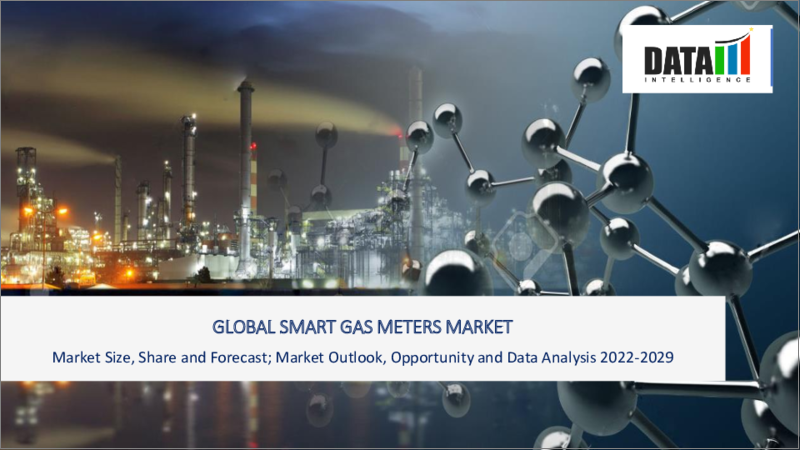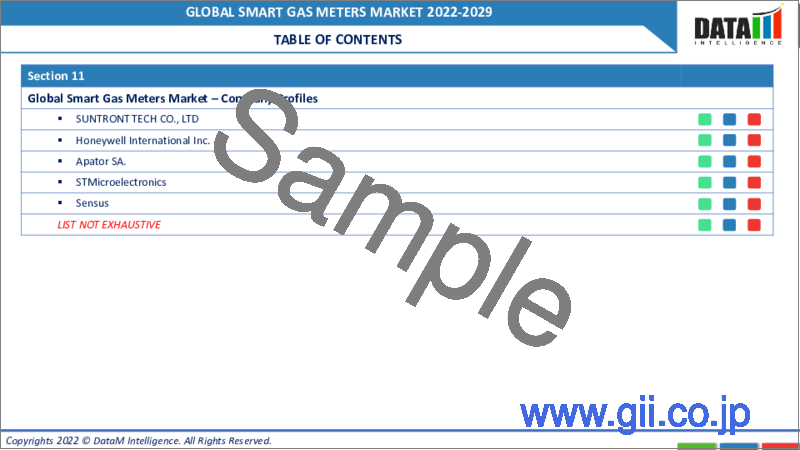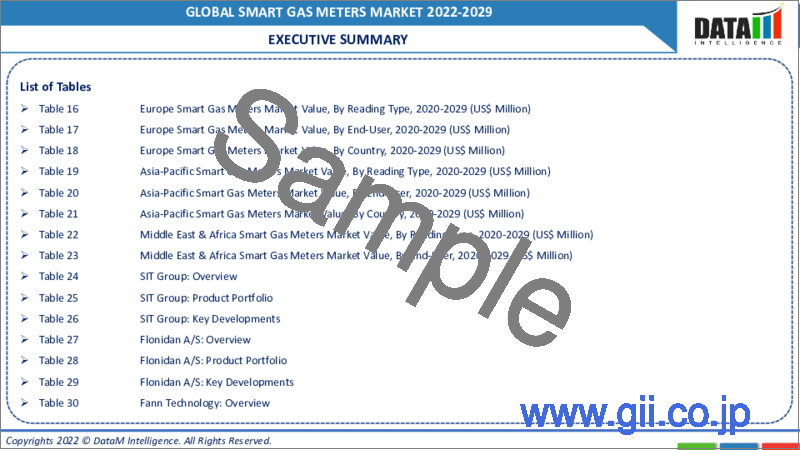|
|
市場調査レポート
商品コード
1042525
スマートガスメーターの世界市場-2022-2029Global Smart Gas Meters Market - 2022-2029 |
||||||
|
● お客様のご希望に応じて、既存データの加工や未掲載情報(例:国別セグメント)の追加などの対応が可能です。 詳細はお問い合わせください。 |
|||||||
| スマートガスメーターの世界市場-2022-2029 |
|
出版日: 2022年07月31日
発行: DataM Intelligence
ページ情報: 英文 200 Pages
納期: 約2営業日
|
- 全表示
- 概要
- 目次
市場力学
先進国での政府機関によるスマートメーターの導入拡大
政府の支援政策、通信ネットワークインフラの拡大、高度な計測インフラの急速な進歩が、スマートガスメーター市場規模を促進する主な要因となっています。公益事業会社は、数多くの利点があることから、これらの技術を採用しています。特に米国、欧州、アジア太平洋地域の政府主導では、エネルギーの効率的な利用を確保するため、住宅へのスマートガスメーターの大規模な配備を目指しています。スマートグリッドの開発は、低炭素経済への移行を実現するための重要な要素であると広く認識されています。
例えば、アメリカの電力会社インディアナポリス・パワー&ライト社は、2020年5月にスマートメーター・インフラ・プログラムの拡張をランディス・ギアに依頼しました。35万個のスマートメーターを追加し、すでに設置されているスマートメーターから中継されるデータを最適化するために電力会社の既存ネットワークを変更し、エネルギー配給管理、再生可能資源の統合、消費者のエネルギー効率、サービス品質の向上に役立てたいそうです。スマートガスメーターの市場は、市場開拓の進展と高度な計測インフラの必要性から拡大しています。
さらに、インドではSmart Meter National Programmeが、インド全域でのユニバーサル・エレクトリック・アクセスという目標の確立に向け、懸命に取り組んでいます。インド政府はスマートグリッドを実現し、消費者に手頃な価格とその他の利点を提供することができます。スマートメーターは、「スマートメーター・ナショナルプログラム」の一環としてインドに配備されています。電力省傘下の電力会社のジョイントベンチャーであるEnergy Efficiency Services Limited(EESL)が、この計画を実施しています。このプログラムでは、エネルギー、水、ガスの使用量に関するデータをさまざまな間隔で収集し、固定通信ネットワークを介して電力会社にデータを転送できる高度なメーター装置が設置され、電力会社から価格信号などの情報を受信して消費者に伝達することができます。
プライバシーとサイバーセキュリティへの懸念がスマートガスメーターの市場成長を阻む
スマートガスメーターから生成されるデータは、消費者の行動を追跡するために利用されます。米国EIAと欧州連合(EU)は、スマートガスメーターによる公共料金の定期的な測定により、家電製品の使用状況や家事行動など、消費者に関するより多くの情報を提供できるとしています。このようなデータは、マーケティングや広告など、商業的な価値も高いです。また、スマートガスメーターは監視インフラとしても活用されています。しかし、スマートガスメーターのデータは、一方でサイバー攻撃やデータ漏洩の危険性があります。法執行機関、保険会社、税務当局、その他の第三者は、スマートガスメーターの個人的なエネルギー使用データに関心を持つ可能性があります。
そのため、米国環境保護庁や欧州データ保護監督庁などの政府機関は、個人情報保護に関するこうした危険性を認識しています。スマートガスメーターの運用に関する新たなデータ保護基準の策定を進めています。プライバシーとセキュリティの問題は、スマートガスメーター市場の成長にとって大きな足かせになると予測されます。
COVID-19影響度分析
スマートガスメーターの市場は、COVID-19の発生により、2020年の市場規模が縮小すると予測されています。COVID-19の大流行により、いくつかの国がウイルスのさらなる拡散を防ぐために全国的なロックダウンを実施したため、電力業界の成長が鈍化しています。IEAの報告書「Energy Efficiency 2020」によると、新型コロナウイルス感染症(COVID-19)の経済的影響の結果、より効率的なエネルギー源の採用に関する世界の進歩は鈍化しています。しかし、諸外国では、2020年前半に住宅用建物の電力使用量が20%増加したのに対し、商業用建物ではおよそ10%減少しています。
パンデミックにより家庭での滞在時間が長くなった結果、エネルギー消費が増加し、エネルギー需要の調整が大きくかつ複雑になったのです。産業用電力消費量の減少に伴い、電力会社は既存の送電網インフラの更新や新規設置にほとんど投資しないと予想されます。さらに、グリッドの近代化投資は、この期間中に減速すると思われます。
世界のスマートガスメーター市場レポートでは、約53の市場データ表、41の図、200ページの構成で提供しています。
目次
第1章 スマートガスメーターの世界市場の調査手法と範囲
- 調査手法
- 調査目的・調査範囲
第2章 スマートガスメーターの世界市場-市場の定義と概要
第3章 スマートガスメーターの世界市場- エグゼクティブサマリー
- 読み取りタイプ別市場内訳
- エンドユーザー別市場内訳
- 地域別市場内訳
第4章 スマートガスメーターの世界市場-市場力学
- 市場影響要因
- 促進要因
- 先進国での政府機関別スマートメータ導入の拡大
- 阻害要因
- プライバシーやサイバーセキュリティに関する懸念が、スマートガスメーターの市場成長を阻害しています。
- プライバシーとサイバーセキュリティに関する懸念
- ビジネスチャンス
- 影響分析
- 促進要因
第5章 スマートガスメーターの世界市場- 産業分析
- ポーターのファイブフォース分析
- サプライチェーン分析
- 価格設定分析
- 規制分析
第6章 スマートガスメーターの世界市場-COVID-19分析
- COVID-19の市場に関する分析
- COVID-19登場前の市場シナリオ
- COVID-19の現在の市場シナリオ
- COVID-19以降、または将来のシナリオ
- COVID-19の中での価格ダイナミクス
- 需要-供給スペクトラム
- パンデミック時の市場に関連する政府の取り組み
- メーカーの戦略的な取り組み
- まとめ
第7章 スマートガスメーターの世界市場- 読み取りタイプ別
- サーキュラーリーディング
- ダイレクトリーディング
- ダイヤフラムガスメーター
- 超音波式ガスメータ
第8章 スマートガスメーターの世界市場:エンドユーザー別
- 商業用
- 住宅用
- 産業用
第9章 スマートガスメーターの世界市場:地域別
- 北米
- 米国
- カナダ
- メキシコ
- 欧州
- ドイツ
- 英国
- フランス
- イタリア
- スペイン
- その他欧州
- 南米
- ブラジル
- アルゼンチン
- その他の南米地域
- アジア太平洋地域
- 中国
- インド
- 日本
- 韓国
- その他アジア太平洋地域
- 中東・アフリカ地域
第10章 スマートガスメーターの世界市場- 競争情勢
- 競合シナリオ
- 市況分析/シェア分析
- M&A(合併・買収)分析
第11章 スマートガスメーターの世界市場-企業プロファイル
- SIT Group
- 企業概要
- エンドユーザー向けポートフォリオと説明
- 主なハイライト
- 財務概要
- Flonidan A/S
- Fann Technology
- Cambridge Consultants
- Pietro Fiorentini S.p.a
- SUNTRONT TECH CO., LTD
- Honneywell Elster
- Apator SA.
- STMicroelectronics
- Panasonic
第12章 スマートガスメーターの世界市場- 重要考察
第13章 スマートガスメーターの世界市場スマートガスメーターの世界市場-DataM
Market Overview
Smart Gas Meter Market is expected to grow at a CAGR of 16.1% during the forecasting period (2022-2029).
A smart gas meter automatically measures the basic properties of the gas flowing through the pipeline, such as pressure, volume and temperature. Government rules and standards have driven the smart gas meter sector to contribute to global GDP growth. Collaboration between gas exploration firms and smart gas meter makers also contributed to the market growth.
Furthermore, increased safety concerns and standards have contributed to double-digit growth in the global smart gas meter market in recent years.
Due to the growing trend of switching from fossil fuels to gas for domestic purposes, gas meters have been increasingly installed in the residential sector in recent years. The government's incentives and subsidies to promote the use of gas are also assisting in expanding the residential sector.
Europe holds a significant market share for smart gas meters due to growing government initiatives for the simultaneous rollout of energy meters, supported mainly by the transforming infrastructure.
Market Dynamics
Growing adoption of smart meters by government institutions in developed nations.
Growing adoption of smart meters by government institutions in developed nations.
Supportive government policies, the expansion of communication network infrastructure and rapid advancements in sophisticated metering infrastructure are the primary drivers driving the smart gas meter market size. Utilities are adopting these technologies because of their numerous advantages. Government initiatives in U.S., Europe and Asia-Pacific region, in particular, aim for a large-scale deployment of smart gas meters in houses to ensure effective energy use. Smart grid development is widely regarded as a critical enabler of the transition to a low-carbon economy.
For instance, the American utility Indianapolis Power & Light chose Landis+Gyr to extend its smart metering infrastructure program in May 2020. They want to add 350,000 smart meters and modify the utility's existing network to optimize data relayed by already installed smart meters, which should help them improve energy distribution management, renewable resource integration, consumer energy efficiency and service quality. The smart gas meter market is growing due to increased development and the need for advanced metering infrastructure.
Furthermore, Smart Meter National Programme is working hard in India to establish its goal of pan-India universal electricity access. The government of India is enabling Smart Grids, which can offer affordability and other benefits to consumers. Smart meters are being deployed in India as part of the Smart Meter National Program. Energy Efficiency Services Limited (EESL), a joint venture of PSUs under the Ministry of Power, is implementing the scheme. As per the program, Advanced meter devices are installed which can gather data on energy, water and gas usage at various intervals and transfer the data to the utility via fixed communication networks, as well as receiving information from the utility such as pricing signals and relaying it to the consumer.
Privacy and cyber security concerns hurdle the market growth of smart gas meters
The data generated from the smart gas meter is utilized to track consumer behavior. As per US EIA and European Union, periodic measurement of utility usage by smart gas meters can provide more information about consumers, such as using residential appliances and housework activities. The data on utility use has much commercial value, for instance, in marketing and advertising. Smart gas meters are also used in surveillance infrastructure. However, smart gas meter data, on the other hand, is prone to cyber-attacks and data breaches. Law enforcement agencies, insurance firms, tax authorities and other third parties may be interested in smart gas meters' personal energy use data.
As a result, government authorities such as U.S. Environmental Protection Agency and the European Data Protection Supervisory Authorities have identified these dangers related to personal data protection. They are developing new data protection standards for smart gas meter operations. The privacy and security problem is projected to be a major stumbling block for the smart gas meter market's growth.
COVID-19 Impact Analysis
The market for smart gas meters is expected to witness a reduction in market value in 2020, resulting from the outbreak of COVID-19. The COVID-19 pandemic has slowed the power industry's growth, as several countries have implemented nationwide lockdowns to prevent the virus from spreading further. According to the IEA report, Energy Efficiency 2020, global progress on adopting more efficient energy sources has slowed as a result of the economic impacts of the novel coronavirus disease (COVID-19). However, in other nations, electricity use in residential buildings increased by 20% in the first half of 2020, while it decreased by roughly 10% in commercial buildings.
As a result of the increased time spent at home due to the pandemic, energy consumption has increased, resulting in major and complex adjustments in energy demand. With the reduced industrial power consumption, utilities are expected to invest very little in replacing existing grid infrastructure and new installations. Furthermore, grid modernization investments will likely slow down during this period.
Segment Analysis
The global smart gas meters market is segmented on reading type, end-user and region.
The government's incentives and subsidies to promote the use of gas are also helping to expand the residential sector
The global smart gas meters market is segmented into residential, commercial and industrial based on end-user. Out of the mentioned end-users, the residential sector is expected to dominate the global smart gas meters market. Due to the growing trend of switching from fossil fuels to gas for domestic purposes, gas meters have been progressively deployed in the residential sector in recent years. The government's incentives and subsidies to promote the use of gas are also helping to expand the residential sector.
Furthermore, the increased number of smart meter gas growth installations in the residential sector is due to the transparency maintained and prices paid based on smart gas usage. Gas meters also aid in identifying high-consumption regions, raising awareness of the need to eliminate energy waste.
Furthermore, due to growing residential sector demand, the companies are also investing in boosting their product line, focusing on smart gas meters for residential applications in 2022; Itron's Intelis residential smart gas meter has been certified for distribution across Canada by Measurement Canada, a government agency that promotes innovation, science and economic growth. Thus, Canada aims to boost utilities' monitoring and management of events occurring within grid networks by deploying smart grids, which will help the country's energy industry decarbonize.
In 2017, UK government's Smart Metering Implementation Programme (SMIP) was overseen by the Department of Energy & Climate Change (DECC), which aims to replace 53 million legacy electricity and gas meters in over 30 million residential premises by 20201. The program is undoubtedly one of the most significant energy infrastructure projects in recent UK history. The government's goal is to install smart energy meters in every home in the UK, allowing customers to monitor their energy consumption and carbon emissions better.
Geographical Analysis
Europe has emerged as one of the priority regions for expanding companies in smart gas meter sales due to significant industry participants and ambitious gas meter rollouts
The number of rollouts by various countries to improve their smart gas meter installations have been the highest in Europe. The shift to renewables to meet long- and short-term green energy goals has resulted in a rise in smart gas meter installations. Due to significant industry participants and ambitious gas meter rollouts, Europe has emerged as one of the priority regions for expanding smart gas meter sales companies.
Italy, UK, Spain, Luxembourg and Sweden are among the major nations in the region that have announced large-scale smart gas meter rollouts. Other countries have begun installing smart gas meters, following in the footsteps of these countries. During the predicted period, this will surely boost the region's growth.
Furthermore, Significant factors driving the rise of smart gas meters have been recognized as the increasing smart gas meter installation, growing awareness of the energy problem and the European directive to cut carbon emissions by 80% by 2050. For instance, in 2020, Regional market companies are taking advantage of the country's numerous growth opportunities to develop strategic partnerships or collaborations to extend their market presence. For instance, Itron, Inc. teamed up with EDMI Limited, a global provider of smart metering systems, to develop and deploy a SMETS2-compliant gas meter. In addition, OVO Energy signed a contract with Aclara Technologies in April 2019 to implement its new SMETS2 meters. OVO energy plans to use these meters to provide a dual fuel smart metering solution to its gas and electric meters. The step is being made to modernize the grids and comply with UK's smart meter rollout program.
Competitive Landscape
The global smart gas meters market is highly competitive with local and global key players. Key players contributing to the market's growth are SIT Group, Flonidan A/S, Fann Technology, Cambridge Consultants, Pietro Fiorentini S.p.a, SUNTRONT TECH CO., LTD, Honneywell Elster, Apator SA., STMicroelectronics, Panasonic and among others.
The major companies are adopting several growth strategies such as product launches, acquisitions and collaborations, contributing to the global growth of the smart gas meters market.
For instance, In August 2020, Flonidan A/S (Denmark) hired Apator SA's subsidiary Apator Metrix S.A. and George Wilson Industries Ltd. to deliver gas meters to UK market.
Panasonic
Overview:
Panasonic Corporation serves its product and solution through eight (8) business domain companies: appliances, life solutions, connected, automotive, industrial solutions, china & northeast Asia, US, and mobility solutions. It has 529 consolidated companies across the world. The company has three Panasonic centers in Tokyo, Osaka and Vietnam.The company has 25 R&D centers, based in Europe, Greater China, Asean, India, North America and Japan.
Product Portfolio:
Smart Gas Meter: The company offers an electronic gas meter that measures gas usage using sensors. Panasonic devices, such as relays and batteries, are best suited to customers' needs. The product offers RE monitoring, pipeline and meter pressure continuous monitoring, valve re-opening after shut-off and battery status monitoring
Key Development
In 2021, Pansonics announced to expand its utility services using smart gas meters in Europe
Why Purchase the Report?
- Visualize the global smart gas meters market segmentation by reading type, end-user and region, highlighting key commercial assets and players.
- Identify commercial opportunities in the smart gas meters market by analyzing trends and co-development deals.
- Excel data sheet with thousands of global smart gas meters market-level 4/5 segmentation points.
- PDF report with the most relevant analysis cogently put together after exhaustive qualitative interviews and in-depth market study.
- Product mapping in excel for the key product of all major market players
The global smart gas meters market report would provide approximately 53 market data tables, 41 figures and 200 pages.
Target Audience 2022
- Service Providers/ Buyers
- Residential
- Research Laboratory
- Restaurant Business
- Energy & Utilities Companies
- Distributors
Table of Contents
1. Global Smart Gas Meters Market Methodology and Scope
- 1.1. Research Methodology
- 1.2. Research Objective and Scope of the Report
2. Global Smart Gas Meters Market - Market Definition and Overview
3. Global Smart Gas Meters Market - Executive Summary
- 3.1. Market Snippet by Reading Type
- 3.2. Market Snippet by End-User
- 3.3. Market Snippet by Region
4. Global Smart Gas Meters Market-Market Dynamics
- 4.1. Market Impacting Factors
- 4.1.1. Drivers
- 4.1.1.1. Growing adoption of smart meters by government institutions in developed nations
- 4.1.1.2. XX
- 4.1.2. Restraints
- 4.1.2.1. Privacy and cyber security concerns hurdle the market growth of smart gas meters
- 4.1.2.2. Privacy and cyber security concerns
- 4.1.3. Opportunity
- 4.1.3.1. XX
- 4.1.4. Impact Analysis
- 4.1.1. Drivers
5. Global Smart Gas Meters Market - Industry Analysis
- 5.1. Porter's Five Forces Analysis
- 5.2. Supply Chain Analysis
- 5.3. Pricing Analysis
- 5.4. Regulatory Analysis
6. Global Smart Gas Meters Market - COVID-19 Analysis
- 6.1. Analysis of COVID-19 on the Market
- 6.1.1. Before COVID-19 Market Scenario
- 6.1.2. Present COVID-19 Market Scenario
- 6.1.3. After COVID-19 or Future Scenario
- 6.2. Pricing Dynamics Amid COVID-19
- 6.3. Demand-Supply Spectrum
- 6.4. Government Initiatives Related to the Market During Pandemic
- 6.5. Manufacturers Strategic Initiatives
- 6.6. Conclusion
7. Global Smart Gas Meters Market - By Reading Type
- 7.1. Introduction
- 7.1.1. Market Size Analysis and Y-o-Y Growth Analysis (%), By Reading Type
- 7.1.2. Market Attractiveness Index, By Reading Type
- 7.2. Circular Reading*
- 7.2.1. Introduction
- 7.2.2. Market Size Analysis and Y-o-Y Growth Analysis (%)
- 7.3. Direct Reading
- 7.3.1. Diaphragm Gas Meters
- 7.3.2. Ultrasonic Gas Meter
8. Global Smart Gas Meters Market - By End-User
- 8.1. Introduction
- 8.1.1. Market Size Analysis and Y-o-Y Growth Analysis (%), By End-User
- 8.1.2. Market Attractiveness Index, By End-User
- 8.2. Commercial*
- 8.2.1. Introduction
- 8.2.2. Market Size Analysis and Y-o-Y Growth Analysis (%)
- 8.3. Residential
- 8.4. Industrial
9. Global Smart Gas Meters Market - By Region
- 9.1. Introduction
- 9.1.1. Market Size Analysis and Y-o-Y Growth Analysis (%), By Region
- 9.1.2. Market Attractiveness Index, By Region
- 9.2. North America
- 9.2.1. Introduction
- 9.2.2. Key Region-Specific Dynamics
- 9.2.3. Market Size Analysis and Y-o-Y Growth Analysis (%), By Reading Type
- 9.2.4. Market Size Analysis and Y-o-Y Growth Analysis (%), By End-User
- 9.2.5. Market Size Analysis and Y-o-Y Growth Analysis (%), By Country
- 9.2.5.1. U.S.
- 9.2.5.2. Canada
- 9.2.5.3. Mexico
- 9.3. Europe
- 9.3.1. Introduction
- 9.3.2. Key Region-Specific Dynamics
- 9.3.3. Market Size Analysis and Y-o-Y Growth Analysis (%), By Reading Type
- 9.3.4. Market Size Analysis and Y-o-Y Growth Analysis (%), By End-User
- 9.3.5. Market Size Analysis and Y-o-Y Growth Analysis (%), By Country
- 9.3.5.1. Germany
- 9.3.5.2. UK
- 9.3.5.3. France
- 9.3.5.4. Italy
- 9.3.5.5. Spain
- 9.3.5.6. Rest of Europe
- 9.4. South America
- 9.4.1. Introduction
- 9.4.2. Key Region-Specific Dynamics
- 9.4.3. Market Size Analysis and Y-o-Y Growth Analysis (%), By Reading Type
- 9.4.4. Market Size Analysis and Y-o-Y Growth Analysis (%), By End-User
- 9.4.5. Market Size Analysis and Y-o-Y Growth Analysis (%), By Country
- 9.4.5.1. Brazil
- 9.4.5.2. Argentina
- 9.4.5.3. Rest of South America
- 9.5. Asia-Pacific
- 9.5.1. Introduction
- 9.5.2. Key Region-Specific Dynamics
- 9.5.3. Market Size Analysis and Y-o-Y Growth Analysis (%), By Reading Type
- 9.5.4. Market Size Analysis and Y-o-Y Growth Analysis (%), By End-User
- 9.5.5. Market Size Analysis and Y-o-Y Growth Analysis (%), By Country
- 9.5.5.1. China
- 9.5.5.2. India
- 9.5.5.3. Japan
- 9.5.5.4. South Korea
- 9.5.5.5. Rest of Asia-Pacific
- 9.6. Middle East and Africa
- 9.6.1. Introduction
- 9.6.2. Key Region-Specific Dynamics
- 9.6.3. Market Size Analysis and Y-o-Y Growth Analysis (%), By Reading Type
- 9.6.4. Market Size Analysis and Y-o-Y Growth Analysis (%), By End-User
10. Global Smart Gas Meters Market - Competitive Landscape
- 10.1. Competitive Scenario
- 10.2. Market Positioning/Share Analysis
- 10.3. Mergers and Acquisitions Analysis
11. Global Smart Gas Meters Market- Company Profiles
- 11.1. SIT Group*
- 11.1.1. Company Overview
- 11.1.2. End-User Portfolio and Description
- 11.1.3. Key Highlights
- 11.1.4. Financial Overview
- 11.2. Flonidan A/S
- 11.3. Fann Technology
- 11.4. Cambridge Consultants
- 11.5. Pietro Fiorentini S.p.a
- 11.6. SUNTRONT TECH CO., LTD
- 11.7. Honneywell Elster
- 11.8. Apator SA.
- 11.9. STMicroelectronics
- 11.10. Panasonic
LIST NOT EXHAUSTIVE
12. Global Smart Gas Meters Market - Premium Insights
13. Global Smart Gas Meters Market - DataM
- 13.1. Appendix
- 13.2. About Us and Services
- 13.3. Contact Us




